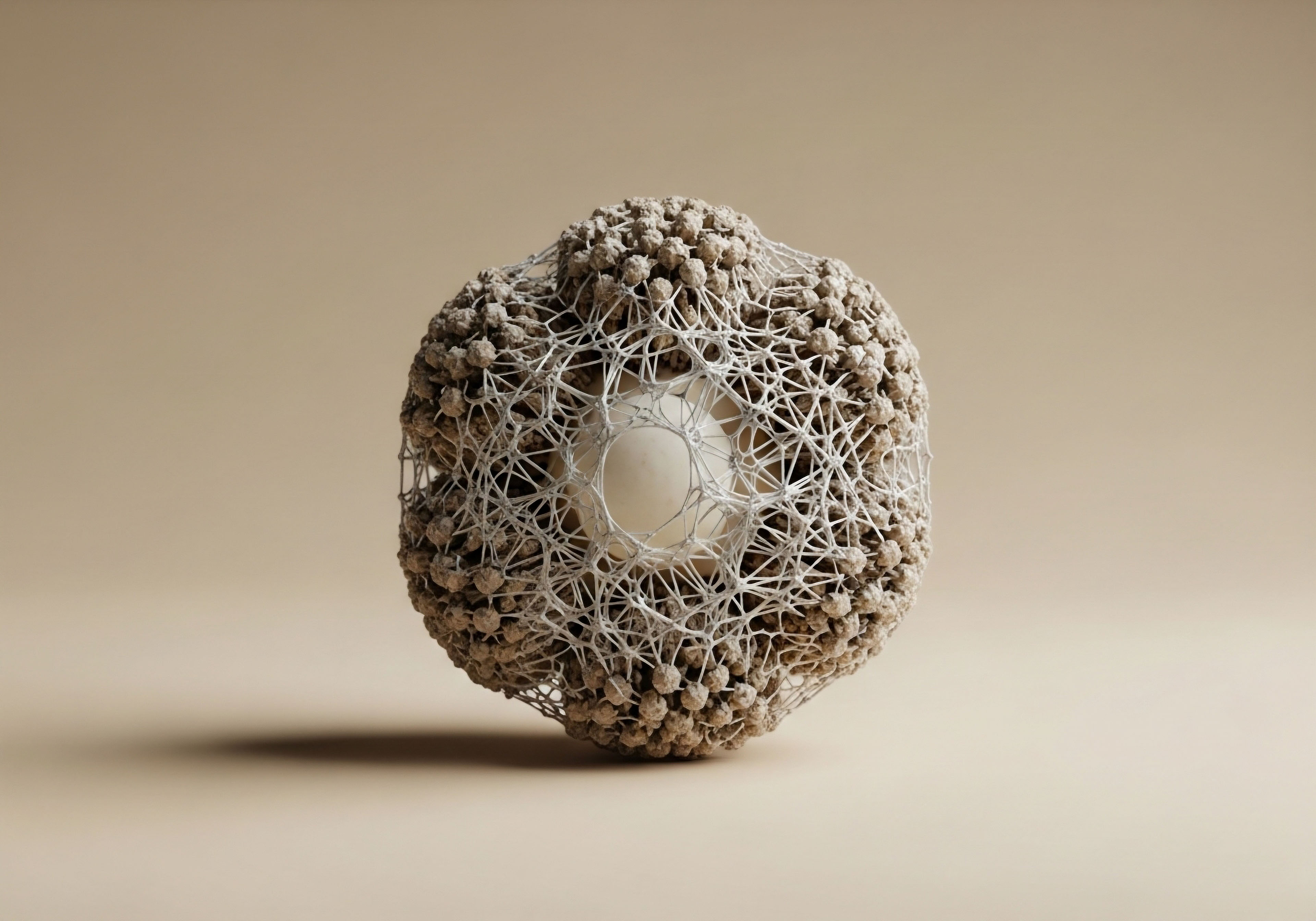

Fundamentals
You may be reading this because you’ve been told your testosterone levels Meaning ∞ Testosterone levels denote the quantifiable concentration of the primary male sex hormone, testosterone, within an individual’s bloodstream. are low, and you’re also managing a heart condition. The feeling of being caught between two significant health concerns can be isolating. On one hand, you are experiencing symptoms that deeply affect your quality of life – a decline in energy, a loss of vitality, a change in your sense of self. On the other hand, you carry the constant awareness of your cardiovascular health, a condition that demands careful attention and vigilance.
This situation can create a sense of uncertainty, a feeling that you are navigating a complex medical landscape with a map that is difficult to read. The desire to feel like yourself again is powerful, yet the concern for your heart is paramount. This is a journey many men face, and it is a journey that requires a thoughtful and comprehensive approach to your well-being.

Understanding Your Body’s Internal Communication
Your body is a complex system of interconnected networks, and hormones are the messengers that facilitate communication between these networks. Testosterone is a key messenger in the male body, playing a vital role in maintaining muscle mass, bone density, red blood cell production, and sex drive. When testosterone levels decline, the messages it carries are diminished, leading to a cascade of effects that you may be experiencing as symptoms.
These symptoms are not just in your head; they are real, physiological responses to a change in your body’s internal environment. Recognizing this is the first step toward understanding your health on a deeper level.

The Heart and Hormones a Delicate Balance
Your cardiovascular system Meaning ∞ The Cardiovascular System comprises the heart, blood vessels including arteries, veins, and capillaries, and the circulating blood itself. is intricately linked to your endocrine system. The heart, blood vessels, and blood itself are all influenced by hormonal signals. Low testosterone has been associated with several cardiovascular risk factors, such as increased body fat, insulin resistance, and changes in cholesterol levels. This creates a complex picture where the very condition you are seeking to treat (low testosterone) may have implications for your existing heart condition.
The decision to consider testosterone therapy Meaning ∞ A medical intervention involves the exogenous administration of testosterone to individuals diagnosed with clinically significant testosterone deficiency, also known as hypogonadism. in this context is a significant one, and it is a decision that should not be made in a vacuum. It requires a careful and considered approach that takes into account your unique health profile.
A collaborative approach to testosterone therapy in the context of heart disease is designed to ensure that your journey toward hormonal balance also supports your cardiovascular health.

Why a Team Approach Is Essential
Managing testosterone therapy when you have a heart condition is a specialized area of medicine. It requires a depth of knowledge that spans multiple disciplines. A single physician, no matter how skilled, may not have the comprehensive perspective needed to navigate this complex terrain. This is where interdisciplinary collaboration becomes so important.
An interdisciplinary team brings together a group of specialists who can view your health from different angles, creating a holistic and personalized treatment plan. This team-based approach is designed to provide you with the safest and most effective care possible, ensuring that all aspects of your health are considered.
The goal of this collaborative approach is to move beyond a simple “fix” for low testosterone. It is about creating a comprehensive wellness strategy that addresses your symptoms, supports your heart health, and empowers you to reclaim your vitality. This journey is about understanding your body as an integrated system and working with a team of experts who can help you restore its natural balance. It is a journey of taking control of your health, armed with knowledge and supported by a dedicated team of professionals who are committed to your well-being.


Intermediate
When considering testosterone therapy for a man with a history of heart disease, the decision-making process becomes a sophisticated exercise in risk-benefit analysis. The conversation moves beyond the immediate symptoms of hypogonadism Meaning ∞ Hypogonadism describes a clinical state characterized by diminished functional activity of the gonads, leading to insufficient production of sex hormones such as testosterone in males or estrogen in females, and often impaired gamete production. to a more comprehensive evaluation of cardiovascular safety. This is where the concept of interdisciplinary collaboration transitions from a theoretical ideal to a practical necessity.
A team of specialists, each with their own area of expertise, can work together to create a treatment plan that is both effective and safe for the individual patient. This collaborative model is built on a foundation of open communication, shared responsibility, and a commitment to patient-centered care.

The Core Collaborative Team and Their Roles
A well-structured interdisciplinary team for managing testosterone therapy in patients with heart disease typically includes a cardiologist, an endocrinologist, a urologist, and a primary care physician. Each member of this team plays a distinct and complementary role in the patient’s care. The synergy of their expertise is what makes this approach so powerful.

The Endocrinologist the Hormone Architect
The endocrinologist is the specialist in hormonal health. Their primary role is to confirm the diagnosis of hypogonadism through a thorough evaluation of symptoms and laboratory testing. They are responsible for designing the testosterone therapy protocol, including the type of testosterone, the dosage, and the frequency of administration.
The endocrinologist also monitors the patient’s hormonal response to treatment, ensuring that testosterone levels are restored to a healthy range without overshooting into supraphysiological levels. They also manage any other endocrine conditions the patient may have, such as diabetes or thyroid disorders, which can also impact cardiovascular health.

The Cardiologist the Guardian of the Heart
The cardiologist’s role is to assess the patient’s cardiovascular risk Meaning ∞ Cardiovascular risk represents the calculated probability an individual will develop cardiovascular disease, such as coronary artery disease, stroke, or peripheral artery disease, or experience a significant cardiovascular event like a heart attack, within a defined future period, typically ten years. profile and determine the safety of testosterone therapy from a cardiac perspective. This involves a comprehensive evaluation of the patient’s heart health, including their history of heart disease, current symptoms, and any relevant diagnostic tests. The cardiologist will work with the endocrinologist to weigh the potential cardiovascular risks of testosterone therapy against its potential benefits.
Once therapy is initiated, the cardiologist will monitor the patient for any cardiovascular side effects, such as changes in blood pressure, lipid levels, or heart rhythm. They will also continue to manage the patient’s underlying heart condition, making any necessary adjustments to their cardiac medications.
The collaborative management of testosterone therapy in cardiac patients involves a continuous dialogue between specialists to dynamically adjust the treatment plan based on the patient’s response and evolving health status.

The Urologist and the Primary Care Physician
The urologist and the primary care physician are also key members of the collaborative team. The urologist is often involved in the initial diagnosis of hypogonadism and may be the one to administer testosterone therapy. They also play a crucial role in monitoring for prostate-related side effects Meaning ∞ Side effects are unintended physiological or psychological responses occurring secondary to a therapeutic intervention, medication, or clinical treatment, distinct from the primary intended action. of treatment, such as changes in prostate-specific antigen (PSA) levels.
The primary care physician acts as the central coordinator of care, ensuring that there is clear communication between all the specialists involved. They also manage the patient’s overall health and well-being, addressing any other medical issues that may arise.

A Table of Collaborative Responsibilities
The following table outlines the key responsibilities of each specialist in the interdisciplinary team:
| Specialist | Primary Responsibilities | Key Monitoring Parameters |
|---|---|---|
| Endocrinologist | Confirms hypogonadism diagnosis, designs and manages TRT protocol, manages other endocrine conditions. | Total and free testosterone levels, estradiol levels, complete blood count (CBC), PSA. |
| Cardiologist | Assesses cardiovascular risk, determines safety of TRT, monitors for cardiovascular side effects. | Blood pressure, lipid profile, electrocardiogram (ECG), signs of fluid retention, symptoms of angina or heart failure. |
| Urologist | Assists with hypogonadism diagnosis, administers TRT, monitors prostate health. | PSA levels, digital rectal exam (DRE), lower urinary tract symptoms (LUTS). |
| Primary Care Physician | Coordinates care between specialists, manages overall health, facilitates communication. | Overall health status, medication reconciliation, patient education and support. |

The Collaborative Process in Action
The interdisciplinary collaboration is not a one-time event but an ongoing process. It begins with a comprehensive initial assessment where all the specialists contribute to the decision-making process. Once testosterone therapy is initiated, there are regular follow-up appointments and communication between the team members. For example, the endocrinologist might share the latest testosterone levels with the cardiologist, who can then assess their potential impact on the patient’s cardiovascular status.
The cardiologist might recommend a change in the patient’s blood pressure Meaning ∞ Blood pressure quantifies the force blood exerts against arterial walls. medication, which the primary care physician would then implement. This continuous feedback loop ensures that the treatment plan is always tailored to the patient’s individual needs and that any potential problems are identified and addressed early on.

What Are the Key Communication Channels for an Interdisciplinary Team?
Effective communication is the lifeblood of a successful interdisciplinary team. The following are some of the key communication channels that can be used to facilitate collaboration:
- Shared Electronic Health Records (EHRs) ∞ EHRs allow all members of the team to access the patient’s medical records in real-time, ensuring that everyone has the most up-to-date information.
- Regular Team Meetings ∞ Scheduled meetings, either in person or virtual, provide an opportunity for the team to discuss complex cases, review treatment plans, and make shared decisions.
- Secure Messaging Systems ∞ Secure messaging platforms allow for quick and easy communication between team members, which is particularly useful for urgent matters.
- Consultation Notes ∞ Detailed consultation notes from each specialist, shared with the rest of the team, provide a clear record of their assessments and recommendations.
Academic
The management of testosterone therapy in men with established cardiovascular disease Meaning ∞ Cardiovascular disease refers to a collective group of conditions impacting the heart and blood vessels, frequently involving narrowed or blocked arteries that can lead to myocardial infarction, stroke, or heart failure. represents a sophisticated clinical challenge that demands a deep understanding of endocrine physiology, cardiovascular pathophysiology, and the principles of collaborative care. The decision to initiate testosterone replacement therapy Meaning ∞ Testosterone Replacement Therapy (TRT) is a medical treatment for individuals with clinical hypogonadism. (TRT) in this patient population is not merely a matter of restoring a single hormone to a numerical target. It is a complex intervention with the potential for pleiotropic effects on the cardiovascular system. A truly academic approach to this issue requires a granular examination of the molecular and cellular mechanisms by which testosterone influences cardiovascular health, and how this knowledge can be leveraged to inform a more precise and personalized interdisciplinary management strategy.

Testosterone’s Pleiotropic Effects on the Cardiovascular System
Testosterone exerts a wide range of effects on the cardiovascular system, acting through both genomic and non-genomic pathways. Understanding these effects is critical for appreciating the potential benefits and risks of TRT in men with heart disease. The following is a detailed exploration of some of the key mechanisms involved:

Vasodilatory Effects
Testosterone has been shown to have direct vasodilatory effects on coronary and peripheral arteries. This effect is mediated, in part, by the opening of potassium channels in vascular smooth muscle cells, leading to hyperpolarization and relaxation. Testosterone can also increase the production of nitric oxide (NO), a potent vasodilator, by endothelial cells. These vasodilatory effects may improve blood flow and reduce blood pressure, which could be beneficial for patients with coronary artery disease or hypertension.

Effects on Myocardial Function
The myocardium contains androgen receptors, and testosterone has been shown to have direct effects on myocardial contractility. Some studies suggest that testosterone can have a positive inotropic effect, meaning it can increase the force of contraction of the heart muscle. This effect may be beneficial for patients with heart failure, a condition where the heart’s pumping function is impaired. However, the clinical significance of this effect is still being investigated, and it is important to note that excessive levels of testosterone could potentially have adverse effects on the myocardium.
A deep understanding of testosterone’s molecular actions on the cardiovascular system is the foundation upon which a truly personalized and collaborative management strategy can be built.

The Role of Aromatization in Cardiovascular Effects
A significant portion of testosterone’s effects on the cardiovascular system are mediated by its conversion to estradiol via the enzyme aromatase. Estradiol has its own set of cardiovascular effects, which can be both beneficial and detrimental. For example, estradiol has been shown to have favorable effects on lipid profiles, increasing high-density lipoprotein (HDL) cholesterol and decreasing low-density lipoprotein (LDL) cholesterol.
However, high levels of estradiol can also have prothrombotic effects, increasing the risk of blood clots. This highlights the importance of monitoring both testosterone and estradiol levels in patients on TRT, and the potential role of aromatase inhibitors in certain individuals.

How Does Interdisciplinary Collaboration Address the Complexities of Aromatization?
The management of aromatization Meaning ∞ Aromatization is a biochemical process where the enzyme aromatase converts androgens, like testosterone and androstenedione, into estrogens, primarily estradiol and estrone. is a prime example of where interdisciplinary collaboration is essential. The endocrinologist can monitor estradiol levels and prescribe an aromatase inhibitor if necessary. The cardiologist can assess the patient’s thrombotic risk and help to weigh the potential benefits of estradiol on lipid profiles against the potential risks of thrombosis.
The urologist can monitor for any estrogen-related side effects, such as gynecomastia. This collaborative approach ensures that the patient’s hormonal milieu is optimized for both symptomatic relief and cardiovascular safety.

The TRAVERSE Trial a Paradigm Shift in Cardiovascular Safety
The recently published TRAVERSE trial Meaning ∞ TRAVERSE Trial is a large, randomized, placebo-controlled study assessing testosterone replacement therapy (TRT) cardiovascular safety in hypogonadal men. has provided much-needed clarity on the cardiovascular safety Meaning ∞ Cardiovascular safety refers to the comprehensive assessment and mitigation of potential adverse effects on the heart and vascular system stemming from medical interventions, pharmaceutical agents, or specific physiological states. of TRT in men with hypogonadism and a high risk of cardiovascular disease. This large, randomized, placebo-controlled trial found that TRT did not increase the risk of major adverse cardiovascular events (MACE) over a median follow-up of 33 months. This finding has been a game-changer in the field, providing reassurance to both clinicians and patients.
However, the trial also found a higher incidence of atrial fibrillation, pulmonary embolism, and acute kidney injury in the testosterone group. These findings underscore the importance of careful patient selection, ongoing monitoring, and a collaborative approach to care.

A Table of Key Findings from the TRAVERSE Trial
The following table summarizes the key findings of the TRAVERSE trial:
| Endpoint | Testosterone Group | Placebo Group | Hazard Ratio (95% CI) |
|---|---|---|---|
| Primary Composite Endpoint (MACE) | 7.0% | 7.3% | 0.96 (0.78-1.17) |
| Atrial Fibrillation | 3.5% | 2.4% | 1.54 (1.17-2.02) |
| Pulmonary Embolism | 0.9% | 0.5% | 1.90 (1.10-3.28) |
| Acute Kidney Injury | 2.3% | 1.5% | 1.52 (1.10-2.11) |

Future Directions in Interdisciplinary Management
The field of testosterone therapy is constantly evolving, and future research will likely focus on developing more personalized approaches to treatment. This may involve the use of genetic testing to identify patients who are at higher risk of adverse events, or the development of novel testosterone formulations with more favorable cardiovascular profiles. As our understanding of the complex interplay between hormones and heart disease continues to grow, the need for interdisciplinary collaboration will only become more pronounced. The future of testosterone therapy lies in a truly integrated approach to care, where specialists from different disciplines work together to optimize the health and well-being of each individual patient.
What Legal and Ethical Considerations Arise in the Collaborative Management of TRT in High-Risk Patients? This question opens up another layer of complexity, involving informed consent, liability, and the communication of risk. The interdisciplinary team must ensure that the patient is fully informed about the potential benefits and risks of TRT, and that their decision to proceed with treatment is made on a voluntary and informed basis.
The team must also have clear protocols in place for managing adverse events and for communicating with each other in a timely and effective manner. These legal and ethical considerations are an integral part of the collaborative care model and must be addressed to ensure the highest standards of patient safety and care.
References
- Rosano, G. M. et al. “Testosterone therapy and cardiovascular diseases.” Cardiovascular Research, vol. 117, no. 10, 2021, pp. 2129-2140.
- Jones, R. D. et al. “Role of Testosterone in the Treatment of Cardiovascular Disease.” European Heart Journal, vol. 38, no. 48, 2017, pp. 3555-3566.
- Hackett, G. et al. “Testosterone Therapy Linked to Reduced MACE Risk in Men with Hypogonadism.” HCPLive, 16 July 2021.
- Lincoff, A. M. et al. “Cardiovascular Safety of Testosterone-Replacement Therapy.” New England Journal of Medicine, vol. 389, no. 2, 2023, pp. 107-117.
- Vigen, R. et al. “Association of testosterone therapy with mortality, myocardial infarction, and stroke in men with low testosterone levels.” JAMA, vol. 310, no. 17, 2013, pp. 1829-36.
- Basaria, S. et al. “Testosterone replacement therapy and cardiovascular risk.” Nature Reviews Cardiology, vol. 16, no. 8, 2019, pp. 483-497.
- Corona, G. et al. “Testosterone Replacement Therapy and Cardiovascular Risk ∞ A Review.” Journal of Endocrinological Investigation, vol. 40, no. 1, 2017, pp. 1-14.
- Nayeri, A. et al. “Research Finds Testosterone Therapy Safe for Heart Health.” Cedars-Sinai, 17 September 2024.
- Rastrelli, G. et al. “Cardiovascular–Endocrine–Metabolic Medicine ∞ Proposing a New Clinical Sub-Specialty Amid the Cardiometabolic Pandemic.” Journal of Clinical Medicine, vol. 14, no. 5, 2025, p. 1324.
- Goodman, N. F. et al. “American Association of Clinical Endocrinologists and American College of Endocrinology Position Statement on the Association of Testosterone and Cardiovascular Risk.” Endocrine Practice, vol. 21, no. 9, 2015, pp. 1066-73.
Reflection
You have now explored the intricate relationship between testosterone, heart health, and the collaborative approach to care that can help you navigate this complex landscape. The information presented here is intended to be a source of knowledge and empowerment, a tool to help you engage in more meaningful conversations with your healthcare providers. Your health journey is unique to you, and the path forward will be one that you co-create with your medical team. The decision to pursue any treatment is a personal one, and it should be made with a clear understanding of your own body, your values, and your goals.
This knowledge is the first step. The next step is to use it to ask questions, to seek clarity, and to advocate for the personalized care you deserve. Your vitality is within reach, and the journey to reclaim it is one that you do not have to walk alone.



















